Chapter 16
An Island Cruise
August—September 1993
The nine islands of the Azores are divided into three groups. The western group of Flores and Corvo are separated by 120
miles from the five central islands which in turn are 80 miles from the western group of São Miguel and Santa Maria. All
the islands are steep-to and most of the harbours are nothing more than a stone jetty for loading ships in a rocky bay. They
are protected only from certain wind and swell directions and you must be prepared to leave if the wind shifts. There are
in fact only three all-weather harbours, all man-made, in all the islands and we were in one of them at Horta on the island
of Faial.*
After recovering from the hangovers of Sea Week (where Oborea won a
trophy for third place in the single-handed race) we left for a cruise of
some of the other islands. From Horta it is only a five mile hop across
the channel to Madelena on the island of Pico, and we motored across
in a flat calm and picked up one of the free moorings for yachts. Pico is
the second largest of the Azores, 42 by 15 kilometers, and has the
highest mountain in Portugal at 2351 metres. It has no large town, but
three small ones and many villages. It appears much rockier and
without the rolling hills of Faial and is a center of grape and wine
production. The vines are not grown on wires here, but on low rock
walls—miles and miles of them—they provide shelter from the wind
and the black lava rock absorbs the sun's heat and radiates it backi into
the grapes.
From Pico it was a 15 mile sail to Velas, the principal town of the island
of São Jorge. This island is long and narrow, 56 by 8 kilometers, and
almost entirely surrounded by cliffs giving it a forbidding appearance from the sea, but the interior is of rolling green hills,
and they make the best cheese in the Azores.
Next stop was Angra do Heroismo on the island of Terceira, another
40 miles on. This is probably the most beautiful city in the Azores. It
grew rich when the Spanish and Portuguese treasure galleons stopped
there on their return voyages from the Americas and there are many
beautiful 16th and 17th century buildings. The city was severely
damaged by a new year's day earthquake in 1980, but it has been
named a UNESCO World Heritage City and has been rebuilt exactly as
before. We had been there less than a week when strong winds from
the south forced us to move from the poorly protected harbour of
Angra to Praia do Vitoria in the north east part of the Island. This is
the second all-weather harbour in the islands and is being developed
as a big container port. There are no special facilities for yachts, but
the holding is excellent in sand and we rode out a southerly gale with
no problem. Praia has one of the best bathing beaches in the Islands,
but the presence of the big USAF base nearby at Lajes has rather
spoiled the area.
On next 80 miles to São Miguel, the largest and most populous of the
Azores and the capital city of Ponta Delgada. The crossing took two
days and a night of very light headwinds and on arrival we found
crowds and traffic and even high rise buildings—all concepts with
which we were no longer familiar! They have even gone beyond
supermarkets and have two hipermercardos. It was all a bit of a
shock. There is a new marina here (just in its second year) It is more
expensive than the one in Horta, but one still has the option of
anchoring in the harbour for free.
This island has some of the most spectacular scenery in the Azores.
We took the bus to the town of Furnas in a deep pine clad valley where
we swam in a lake fed by hot volcanic springs and where they cook a
local stew by burying sealed pots in the hot earth. We met a friend
from Toronto who was visiting his parents in the north part of the
island and we were invited their home and rode horses up the hills and down into a volcanic crater so large it contains
seven lakes, innumerable farms and a small town. The near vertical sides of the crater were covered in the huge yellow
flowers of wild ginger and eagles or açores soared in the updraughts as the sun sparkled on the lakes far below.
While in Ponta Delgada we made a major change in our plans. We had
earlier fallen in love with the island of Faial and had considered buying
a retirement home there. We were torn because we wanted to continue
sailing fo a while, but on the other hand real estate prices would never
be as low again as even here things are always going up. We had looked
at several houses and were interested in one in particular. We had left
however without coming to any sort of decision. In Ponta Delgada we
were waiting for our friends on the Toronto monohull Here and Now
to arrive, they had followed us from Florida to Bermuda to Horta, and
when we had left them there we had agreed to meet again in Ponta
Delgada and sail to Europe together. Instead of Here and Now though
we got a message that they were still in Faial. They had been offered
the job of caretaking a house for an American woman who was
spending the winter in California and they had jumped at it. This decided us and we have sailed back 150 miles to Horta
and bought the house in which we were interested (for less than $12000 Canadian) It is in the rural village of Cedros
about twenty-two kilometres from Horta and we have bought a twenty year old Austin to commute. The house is a
typically Azorean single story structure with stone walls two and a half feet thick. Right now we are still living on Oborea
as we have to do some renovations, but we hope to move in by mid November and then we will be landlubbers until at
least next spring, when we can continue our voyage to Europe knowing that we always have our home to return to.
THE END OF OBOREA’S THIRD CRUISE
* Note: this was written almost 25 years ago, there are now (in 2017) well-sheltered marinas on most of the islands
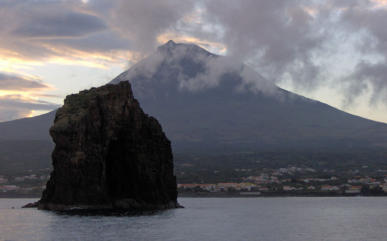
Approaching Madelena, Pico
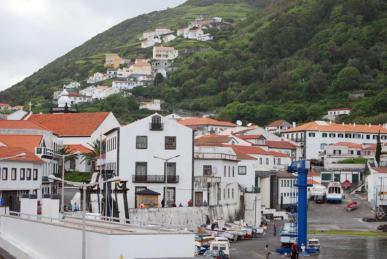
Velas, São Jorge
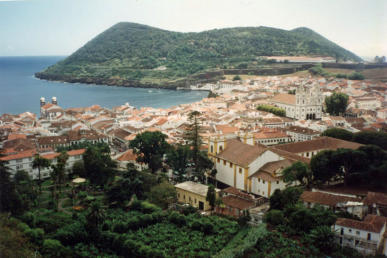
Angra do Heroismo
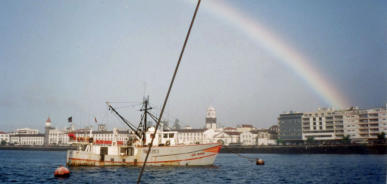
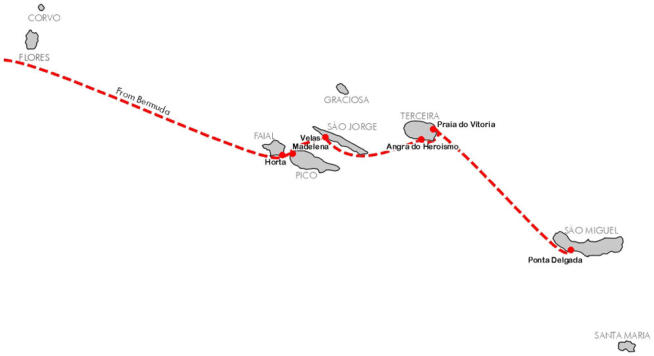
Ponta Delgada